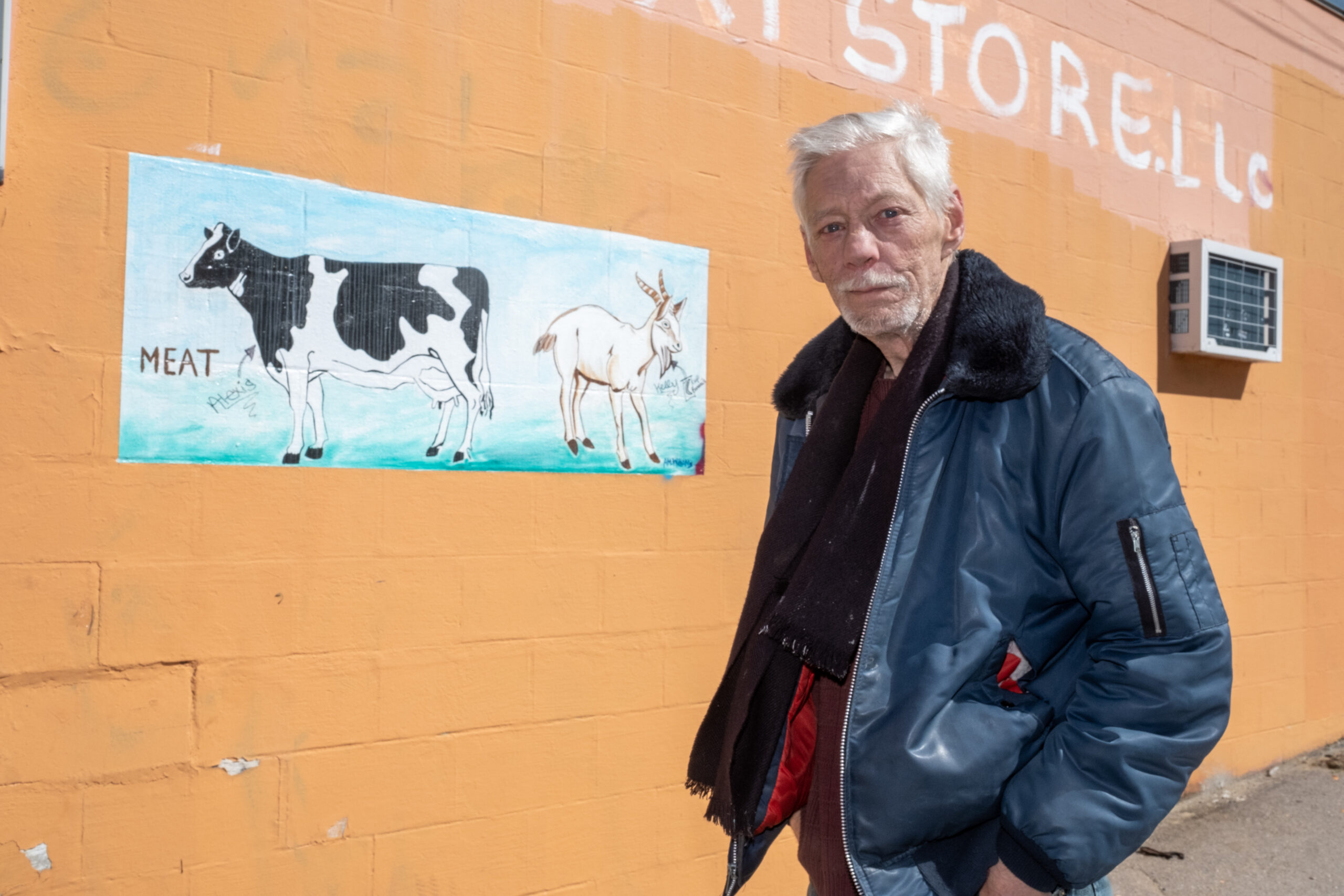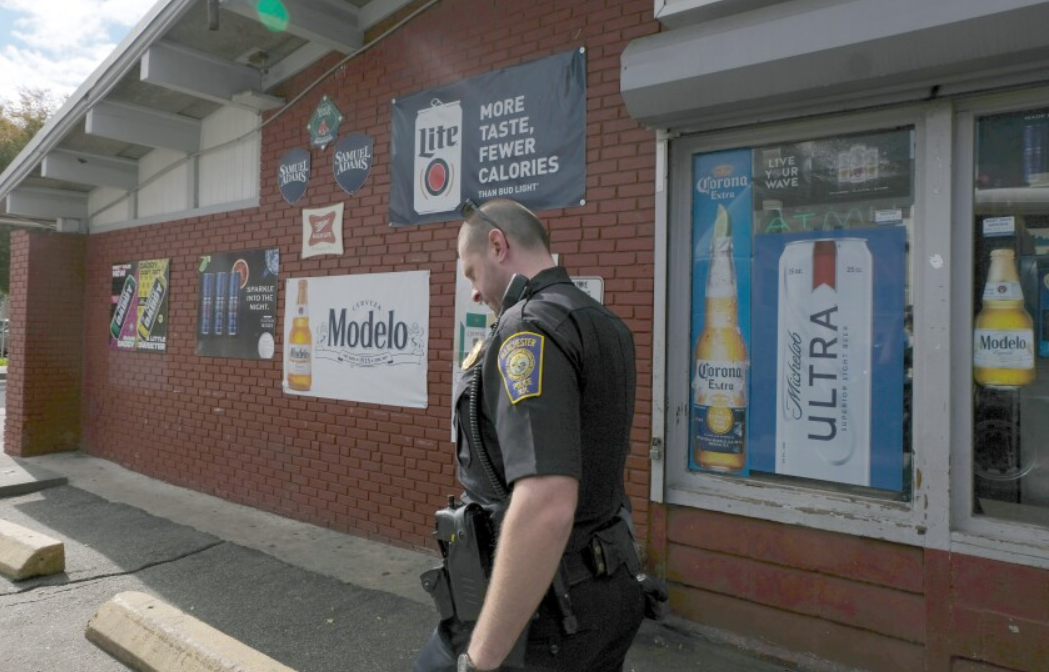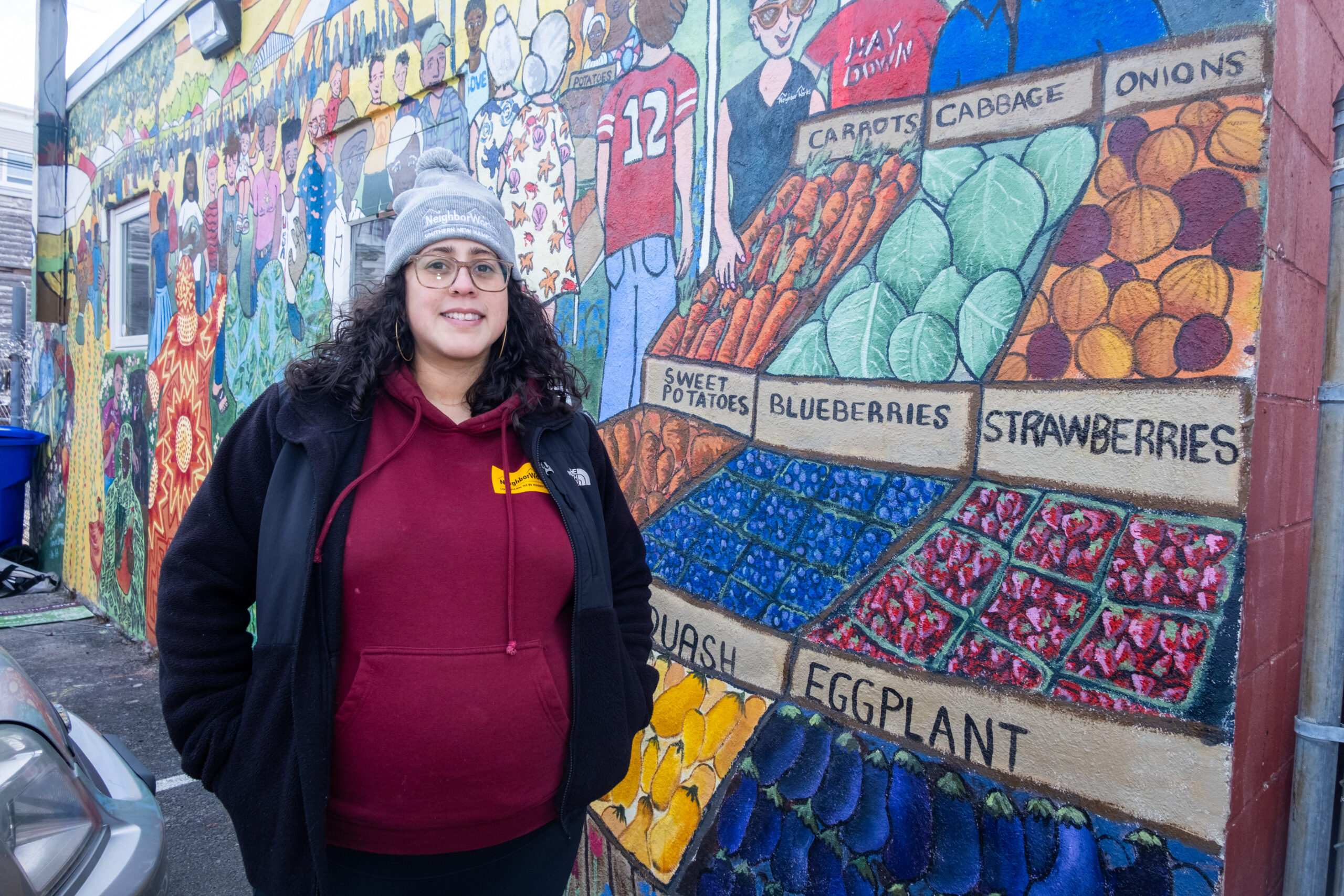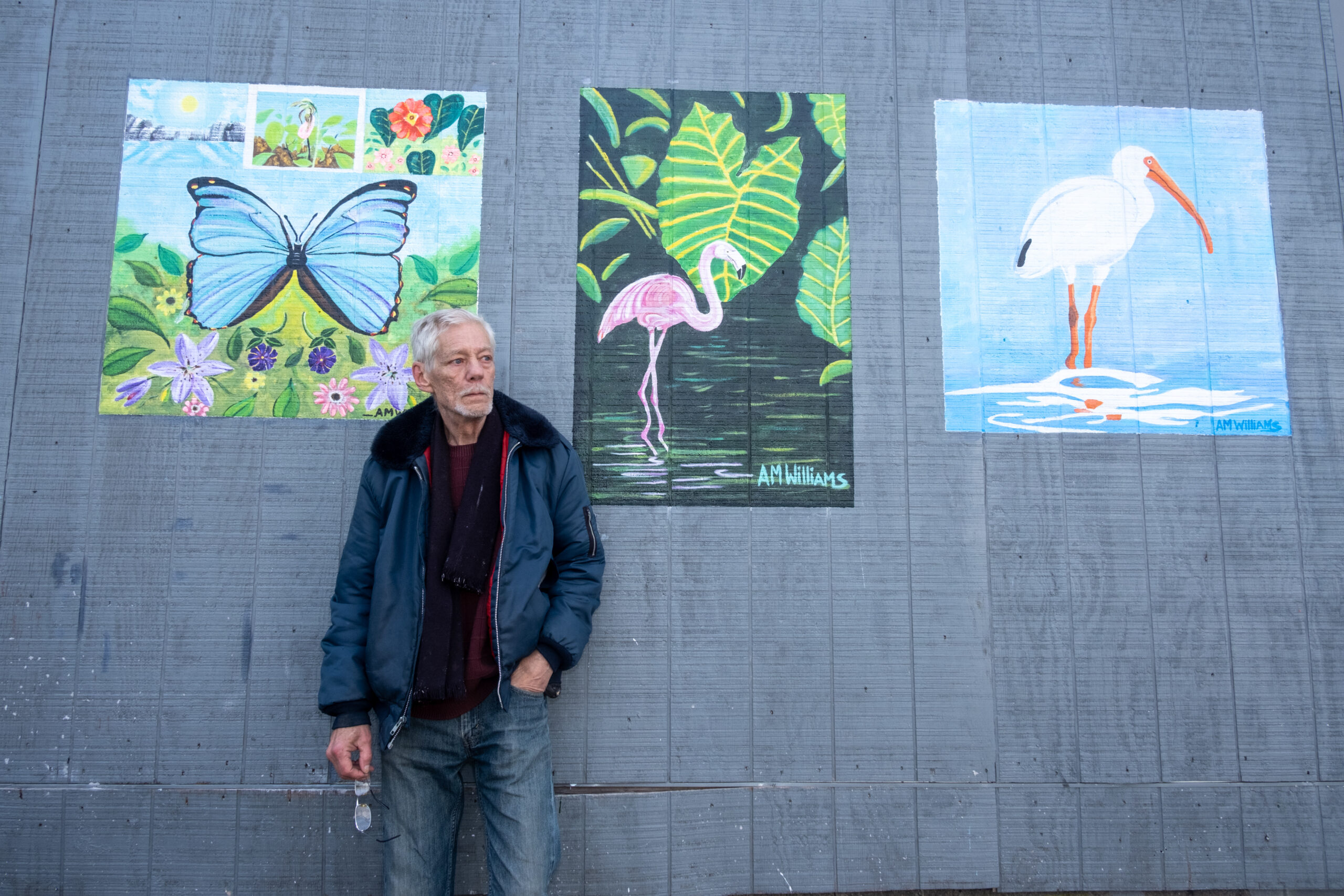
Editor’s note: This article is another installment of “Invisible Walls,” an ongoing joint project examining how exclusionary zoning laws have reinforced areas of persistent poverty, impacting many aspects of community life, including crime, public health, affordable housing and access to economic opportunity in Manchester. The team used Manchester as a case study, but the same sorts of exclusionary zoning practices present in Manchester are common across the state, and likely have had similarly broad effects.


⇒ RELATED STORY: Is there a relationship between zoning and crime?
MANCHESTER, NH – Recently, Manchester artist Anthony M. Williams got an email from Hsiu Chang, a landlord who owns 15 Queen City properties, mostly in center city. Williams had previously painted murals on five of Chang’s properties, and now Chang had a new request: could Williams paint the satellite dishes hanging off his multi-family properties, transforming them from an eyesore into something beautiful?
“There’s something about murals,” said Williams, 71, as he considered the logistics of painting the satellite dishes.
In Manchester, center city is notorious for its high crime rate and low-income, high-density housing. But a nonprofit and a neighborhood initiative are trying to change that with community engagement and beautification initiatives that include installing artwork throughout the neighborhood.
“When people see pretty things in their neighborhood they can’t believe they have something like that and they want to respect that,” said Erica Brooks, 34.
Brooks is the organizer of the Center City Neighborhood Group, a monthly gathering of stakeholders in the area who want to improve center city. The group is focused on creating solutions to problems in the neighborhood, while building connections and making people aware of existing resources.
The mural project was proposed as a solution to trash-filled properties populating the neighborhood. Once the idea was brought up, Brooks, who is the community building manager for NeighborWorks Southern New Hampshire– a non-profit focused on improving access to affordable housing– secured funds to help make it happen. NeighborWorks pays for half of the cost of a mural installation, while the property owner splits the other half. So far, 13 murals have been painted under the project.
“We’re rewriting a narrative,” Brooks said. “People think because there are drugs and crime that this is a terrible place to live. But it’s affordable, there are different cultures, it’s walkable. We’re giving people a sense of pride: you enjoy living here.”

Beautification, born from violence
It was a brazen midday shooting near the Don Quijote restaurant on Union Street in 2016 that galvanized Brooks and the others.
“It made people feel unsafe,” said Brooks, who was living in the neighborhood at the time. She began gathering community members together for the Center City Neighborhood Group. At first, people just wanted to vent, but Brooks pushed the group to consider real solutions.
“It meant losing people who just wanted to have a negative view and not do anything about it,” she said.
By 2018 and into 2019 the group was thriving. About 20 community members, including elected officials, attended each monthly meeting at Hope Tabernacle church on Cedar Street, where her dad, John Rivera is the pastor.
Brooks built a plan for the meetings. For six meetings a year she would bring in community organizations like the Health Department, Cooking Matters NH or Healthy Homes. The idea was to show community members the existing resources that they could tap into.
“It was really helpful for the community to understand they have awesome things already happening,” Brooks said. “We don’t have to reinvent the wheel.”
For the other six meetings, the group focused on building solutions for areas where there were gaps in resources. The mural project and community cleanups arose from those meetings.
Having different community initiatives in the same room amplified connections, said Rivera.
“It’s good to be around like-minded people who want to impact the neighborhood for good,” Rivera said.

Through the group, Rivera met local business owners who he hadn’t previously connected with during his years in Manchester. He also forged a relationship with the city Welfare Department, through which he learned that the department was sometimes able to fund a person’s first month of rent for a new apartment, but was unable to contribute to the security deposit. Hope Tabernacle and other local churches started a program to provide security deposits, which have helped about five families access housing.
The group also identified what Brooks calls hot spots in the neighborhood — areas where issues like crime and vandalism were most apparent. Then, Brooks invited officers from the Manchester Police Department to attend. Officers often attended in plain clothes, and being in a neutral place rather than the police station, helped encourage more open conversation, Brooks said.
Officers have now been attending meetings for about five years, at the same time that the department has increased foot patrols in the Center City neighborhood. That’s given community members a chance to get to know officers, Brooks said, building rapport at a time when relationships between police and communities of color are strained.
“It’s important for children to see that not all police officers are bad guys,” Brooks says. “They desire to help and they’re people too.”
The Center City Neighborhood Group also established a Little Free Library, which was a success for years. More recently, people began hiding drugs in it. The police were able to respond to that, Brooks said. Still, setbacks like that can be disheartening.
“It’s hard to see,” Brooks said.

From broken windows to local art
When the Center City Neighborhood Group members propose solutions, Brooks finds funding, often from Neighborworks. That’s what happened with the mural project, the neighborhood group’s largest initiative.
“In a neighborhood that people think no one cares about, there are crimes and other issues,” Brooks said.
The neighborhood group approached business owners and landlords about splitting the cost of murals to beautify the area. Hope Tabernacle used a cityscape mural to cover vulgar graffiti. Chang spent about $1,000 on murals, with plans to add more.
“There has been no tagging at the mural sites,” said Chang, who lives in the neighborhood in addition to owning investment properties. “The area also seems to be cleaner. People want to keep the area nicer.”
When one landlord buys into improvements, others are more likely to do so, said Brooks. One landlord with a subpar reputation for property maintenance has made regular improvements to their properties since they started attending, said Brooks.
“Even though they haven’t fully changed completely, they redid the outside, replaced the doors, and cleaned up trash because they knew someone was looking,” said Brooks.
Getting locals involved is the same approach that Williams takes with his murals. He often invites local kids and teens to paint alongside him.
“I really believe that when you include these boys and girls, you’ve made a relationship there. You’ve made that young person look and see their name at the bottom of that mural. It doesn’t get tagged, and it doesn’t get destroyed,” he said.
It takes Williams about a week to complete a mural. When he was working on a piece on one of Chang’s properties a neighboring family brought him a plate of food. The father told Williams he had watched him working every day; that he appreciated the artwork and would take care of it. Williams’ reply was simple.
“I said, ‘It’s yours. It’s for everybody in this town.’”

Local Buy-in and the Ripple Effect
Janine Woodworth has been a renter near center city neighborhood for 17 years. When she reached out to her alderman about improving her ward, he directed her to the Center City Neighborhood Group.
Woodworth had already made a practice of keeping her home and the area around it tidy.
“Though I don’t own the house I try to keep things neat if I can,” she said. “It’s a reflection on anyone that lives here.”
When the Center City Neighborhood Group asked members to propose a project that would improve their immediate community, Woodworth thought about nearby Enright Park, where they were often dog feces. She proposed a dog waste bag dispenser, which NeighborWorks paid for and installed. Community members, including prostitutes who worked around the park, commended Woodworth for helping clean up.
More recently, when Woodworth noticed that the signs around the park were illegible, she repainted them. A neighbor told her “If anybody touches that sign, they’ll have to deal with me.”
Since then, no one has graffitied the sign, which Woodworth calls a “pleasant surprise.”
“It’s about getting that buy-in by the people who live there,” she said.
Progress, then lost momentum
Despite best efforts, the pandemic took a toll on the group.
“Switching over to Zoom lost momentum,” Brooks said.
Though the group has since returned to in-person meetings, attendance is usually below 10. There are still community owners and business leaders, but not as many community residents.
Brooks hopes to build up engagement with residents through upcoming events including community cleanups and a wellness day.
“When we were at our greatest, we had your regular neighborhood people,” she said.
Still, not all momentum has been lost.
Though the engagement from the police department has waxed and waned over the years with staff turnover, at the Center City Neighborhood Group’s March meeting, five officers were present. They talked with group members about issues in the neighborhood and asked for understanding as the department reevaluated its community policing program. Both sides were able to listen to each other, Brooks said.
“It was the best meeting in a long time,” she said.
Making lasting changes in a transient neighborhood can be challenging. But Brooks hopes that small changes will add up over time.
“That’s what we want to do: Building by building, block by block, give people the opportunity to see that they can make a little change,” she said.
 These articles are being shared by partners in The Granite State News Collaborative as part of our race and equity project. For more information visit collaborativenh.org.
These articles are being shared by partners in The Granite State News Collaborative as part of our race and equity project. For more information visit collaborativenh.org.







